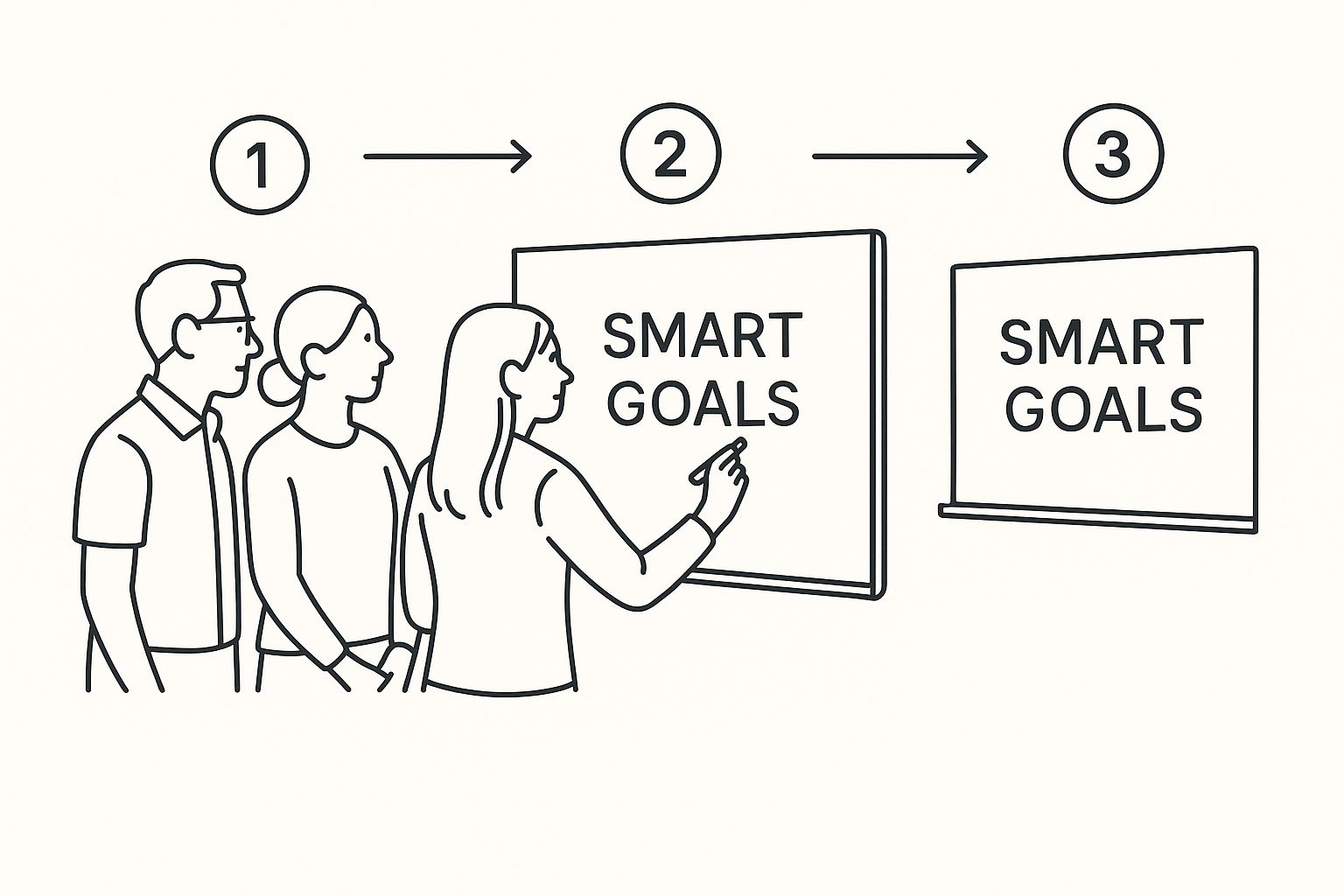Boosting your team's productivity isn't about cracking a whip or demanding longer hours. It's about working smarter, not harder. From my experience, the most impactful change comes from building a solid foundation on three core pillars: crystal-clear communication, intelligent tool integration, and a culture that fiercely protects deep work.
When you get these three things right, something clicks. The team shifts from just being busy to being genuinely effective.
Redefining Team Productivity in the Modern Workplace
In today's fast-paced world, the old-school metric of "hours logged" is just about useless. Real productivity isn’t about looking busy in a flurry of activity; it’s about consistently delivering meaningful results with less friction. This requires a fundamental change in how we think—moving away from tracking individual tasks and focusing on collective outcomes.
At the heart of this shift is one powerful driver: employee engagement.
A disengaged team will always struggle with productivity, no matter how many fancy tools or processes you throw at them. And it's a huge problem. A landmark Gallup survey found that a staggering 79% of employees globally are not engaged at work. This isn't just a "people problem"; it has a massive financial impact, costing the global economy trillions in lost productivity.
Time and again, the research points back to one thing: leadership. Disengaged teams are almost always a symptom of poor management and muddled communication.
The Core Pillars of Modern Team Productivity
To actually fix this, leaders need to stop applying band-aids and start reinforcing the foundation. These pillars aren't just buzzwords; they're a practical system that creates an environment where high performance can happen naturally.
Before we dive into the "how," let's quickly summarize what these pillars are and why they matter. The table below breaks down the key focus for each one and the result you should be aiming for.
| Pillar | Key Focus Area | Expected Outcome |
|---|---|---|
| Clear Communication | Establishing shared "rules of engagement" for how, when, and where the team communicates. | Reduced notification noise, transparent goals, and less time wasted in chaotic email threads. |
| Smart Tool Integration | Configuring technology to automate handovers and remove manual friction. | Maintained momentum on projects, even when key people are out, and fewer process bottlenecks. |
| A Culture of Deep Work | Actively protecting focused, uninterrupted time for high-value tasks. | Higher quality output, reduced burnout, and empowering team members to disconnect without guilt. |
These aren't separate initiatives; they're interconnected parts of a whole. A team with great tools but no clear communication will still be chaotic. A team that values deep work but has clunky tools will be frustrated. You need all three working in concert.
Let's break down what each of these looks like in practice.
-
Clear Communication: This is all about setting ground rules. It means deciding which channels are for urgent pings and which are for general updates. It means setting clear expectations for response times so no one feels pressured to be online 24/7. When everyone knows the rules, the chaos subsides.
-
Smart Tool Integration: Your tech stack should feel like a helping hand, not another obstacle. This is where tools like the Out of Office Assistant for Jira come in. By configuring it to automate handovers, you prevent work from stalling just because someone is on vacation. When your tools work for you, momentum is maintained without anyone having to chase down updates.
-
A Culture of Deep Work: Constant interruptions are the silent killer of productivity. Fostering a culture that values deep work means actively creating space for focus. This could be promoting asynchronous communication, setting up "no-meeting" blocks in the calendar, or simply empowering people to turn off notifications and disconnect without feeling guilty.
Ultimately, leadership is the glue that holds these pillars together. An effective leader doesn't just manage tasks; they architect an environment where clear communication, smart tools, and deep work are the default, not the exception.
Your tech stack should be a tailwind for your team, not a headwind. When tools are clunky or used inconsistently, they create friction, kill momentum, and pile on needless manual work. The secret to boosting team productivity is making your tools do the heavy lifting for you—especially when it comes to automating handovers and keeping projects alive when people are out.
One of the most common—and frustrating—productivity killers is the dreaded project stall. It happens every time a key team member takes a vacation or unexpected leave. Without a solid system in place, tickets languish, approvals get stuck in limbo, and deadlines start to look more like suggestions. This is where smart tool configuration isn't just a nice-to-have; it's a strategic necessity.
Preventing Bottlenecks with Proactive Availability Management
Picture this: your lead developer is about to head off for a well-deserved two-week vacation. In a lot of setups, any Jira ticket assigned to them would just sit there, gathering dust until they get back. That's a classic bottleneck, and it has the power to derail an entire sprint.
Now, let's replay that scenario with a smarter approach.
Using a tool like the Out of Office Assistant for Jira Cloud, the team lead can set up an absence rule before they even pack their bags. This rule can automatically reassign any incoming tickets to a designated backup developer for the entire time they're gone.
This one simple configuration sends powerful ripples through the workflow:
- No More Stalled Work: Critical bug fixes and urgent tasks are immediately passed to someone who can actually work on them.
- Clear Ownership: The backup developer isn't left guessing. They know exactly what's on their plate, which cuts out all the confusion.
- Sustained Momentum: The project just keeps chugging along. Timelines are protected, and the team’s velocity doesn't take a hit.
The right processes, like automated handovers, are fundamental to creating a productive workflow. When goals are clear and the path to get there is smooth, teams can execute far more effectively.

A Real-World Walkthrough in Jira Cloud
Let's walk through another all-too-common situation. A product manager is heading to a week-long conference and will have spotty access to Jira at best. The problem? They are the main approver for new features in a Jira Service Management project.
Instead of letting a mountain of approvals build up, they can jump into the Out of Office Assistant and configure a specific rule just for this.

As you can see, the interface is incredibly straightforward. Just pick the dates, select who's covering for you, and add a quick custom message. Done. The handover is seamless.
This isn't just a clever tech trick; it's a core part of strategic resource management. By managing availability transparently, teams get much better at planning sprints and allocating work effectively. For a deeper dive, we have a whole guide on optimizing resource allocation you can check out.
Key Takeaway: Automating how you handle absences transforms team availability from a potential risk into a predictable, manageable part of your workflow. It gives people the freedom to take guilt-free time off, knowing their responsibilities are handled.
This is absolutely crucial for distributed teams. When you're optimizing for productivity, you have to think about how your workflows support different team structures. The principles of clear handovers and automated assignments are also foundational to effective strategies for nearshore development team workflows, making sure collaboration is seamless no matter where your team members are. Proper configuration ensures the work flows smoothly, period.
Make Room for Deep, Focused Work

Sure, having the right tools is a big piece of the puzzle, but they're only half the story. If you really want to move the needle on team productivity, you have to tackle the biggest roadblock to high-quality work: constant interruptions.
The modern workplace feels like a minefield of distractions. The ability to just sit down and concentrate on a single, tough task—what we call deep work—has become incredibly rare, and therefore, incredibly valuable.
Creating a culture that actively defends this state of focus isn't some "nice-to-have" perk. It's a core strategy. When your team can finally escape the endless stream of pings and shoulder-taps, you'll see a massive jump in the quality and quantity of their output. It's about making concentration the default, not the exception.
Set Up Clear Rules for Communication
First things first, you’ve got to tame the communication chaos. When there are no guidelines, every single message feels urgent, and your team ends up chained to their inboxes and chat apps.
A simple, yet powerful, first step is to create a team-wide communication protocol. This isn't about micromanaging, but about creating a shared understanding of how and when to communicate. The goal is to take the mental guesswork out of how we talk, so the team can focus on what they're actually saying.
Here's what this might look like in practice:
- Email: Use this for non-urgent, detailed info that can wait a bit. The expectation? A response within 24 hours.
- Chat (like Slack or Teams): Perfect for quick questions or updates that need a same-day answer but aren't full-blown emergencies.
- Calls/Meetings: Save these for the truly complex, collaborative discussions or genuine emergencies that need everyone's attention right now.
By simply defining the "why" behind each channel, you give your team permission to disconnect. They get the psychological safety to turn off notifications, knowing they won't miss a true five-alarm fire. This small change alone can free up hours of productive time every week.
Protect Everyone's Focus Time
Managing notifications is a great start, but you also need to formally protect blocks of time for uninterrupted work. This is where "focus time" comes into play.
Encourage everyone on your team to block off 2-3 hour chunks in their calendars. These blocks are sacred—no meetings, no calls, and absolutely no expectation of an immediate reply to a message.
As a leader, you have to lead by example. When you respect your team's focus blocks and avoid scheduling over them, you send a clear signal that deep work is something the company genuinely values. This is especially critical for remote and hybrid teams, where digital distractions are everywhere.
Research shows that the average office worker gets interrupted every three minutes, and it can take over 23 minutes to get back on track. That's a massive productivity killer. Carving out intentional quiet time is the only real defense.
A big part of making this work is teaching your team how to properly delegate tasks before they sign off for focus time or go on vacation. Knowing that critical work is covered allows people to truly unplug without creating bottlenecks for everyone else. To get your team up to speed, you can check out our guide on effective task delegation.
Establish Clear Goals and Continuous Feedback Loops

A team without a clear direction is like a ship without a rudder. They might be incredibly busy, but they're ultimately just adrift. To really boost productivity, every single action needs to be anchored to a specific, measurable outcome. Vague goals like "increase sales" just don't cut it; you need something concrete to drive real progress.
This is where frameworks like OKRs (Objectives and Key Results) are so effective. They give you a structured way to break down high-level company ambitions into tangible work for your teams and the people on them. When everyone can draw a straight line from their daily tasks to the company's bigger picture, their sense of purpose—and motivation—goes through the roof.
From Company Vision to Individual Tasks
The real magic of a good goal-setting framework is how it creates that clear line of sight. For instance, a big company objective like "achieve market leadership" could translate into a team objective to "launch three new integrations this quarter."
From there, it breaks down even further into individual key results:
- A developer's key result might be to complete the API connection for Integration X.
- A marketer's key result could be to generate 50 qualified leads for the new features.
All of a sudden, those daily tasks aren't just items on a to-do list. They’re meaningful steps toward a shared win. This kind of clarity cuts out wasted effort and makes sure everyone is pulling in the same direction. Of course, you have to balance these new goals with the team's current work. You can get some great ideas on how to do that by exploring different workload management strategies.
Foster a Culture of Continuous Feedback
Setting goals is only half the battle. Without a way to have an ongoing conversation, even the best-laid plans can fall apart. Let's be honest, the old model of a single, dreaded annual performance review is dead. High-performing teams run on a culture of continuous, constructive feedback.
A Gallup study found that employees who get daily feedback from their manager are 3.6 times more likely to be motivated to do outstanding work. This isn't about micromanaging. It's about staying connected and making small course corrections along the way.
This feedback loop needs to become a natural part of your team's rhythm.
- Weekly One-on-Ones: These are not status updates. They're dedicated time to talk about progress, clear up any roadblocks, and offer genuine support.
- Project Retrospectives: After a project or sprint, get the team together. Talk openly about what went well and what you can do better next time.
- Celebrating Small Wins: Don't wait for the big finish line. Acknowledging small steps of progress in team chats or meetings builds incredible momentum and keeps morale high.
When you bring together clear, cascading goals with a strong feedback loop, you create a powerful cycle of alignment, adaptation, and learning. This is the bedrock that allows a team to not just be productive, but to consistently deliver exceptional work.
How to Sidestep Common Productivity Traps
Sometimes, the biggest threats to your team's productivity aren't the obvious roadblocks. They’re the subtle, counterproductive habits that sneak into our workflows, often disguised as diligence. Even with the best tools, these traps can quietly drain your team's energy, focus, and morale.
Spotting them is the first step. Let's walk through some of the most common ones I've seen trip up even the sharpest teams.
One of the most classic pitfalls is micromanagement. It almost always starts with good intentions—a manager just wants to ensure quality work and stay looped in on all the details. We've all been there.
But the outcome is a team that feels disempowered and untrusted. Instead of fostering real ownership over their work, it creates a culture of dependency where people are almost afraid to make a move without getting the green light. That’s a recipe for paralysis, not progress.
From Looking Busy to Being Effective
Another trap I see all the time is what you might call "productivity theater." This is when the focus shifts from achieving real, meaningful results to just looking busy.
It shows up in teams that glorify working late, prize lightning-fast chat responses over deep, thoughtful work, and generally celebrate activity over actual progress. This constant pressure to be "on" is a direct path to burnout and shallow, surface-level work.
Here’s a startling fact: research shows that 82% of managers admit they have "limited to no" ability to hold others accountable effectively. When there's an accountability gap, it's easy to fall back on micromanagement or productivity theater. Neither drives the results you actually want.
The way out is to deliberately shift the team's focus from activity to outcomes. Start celebrating completed goals, not just the hours logged. Praise the quality of a finished project, not how quickly someone replied to a Slack message.
The Hidden Cost of Tool Overload
Finally, let's talk about tech. Having too many tools—or using them inefficiently—is a surefire way to create chaos. When information is scattered across email, a handful of chat channels, and various project management boards without clear guidelines, things fall through the cracks. It's inevitable.
This setup forces team members into a constant state of context switching, which absolutely kills focus and creates a ton of unnecessary mental friction. It’s exhausting.
To get a handle on this, you need to simplify and bring clarity to your systems:
- Audit your tech stack. Seriously, are there redundant tools? Can you consolidate some of them? Be ruthless.
- Create a communication protocol. Get everyone on the same page about which tool is used for what. For example, urgent updates go in Chat, formal announcements in Email, and task progress in Jira.
- Integrate your tools intelligently. This is where things get powerful. Using features like the Out of Office Assistant in Jira can automate handovers and ensure there's system-level clarity when people are away. No more guesswork.
Building a resilient team means proactively managing these systems. It's why developing clear and effective absence management strategies is so critical for keeping momentum and preventing burnout. When you learn to spot these traps and put practical solutions in place, you can cultivate a team culture that thrives on genuine, sustainable productivity.
Got Questions About Team Productivity?
Even when you have a solid game plan, theory and practice can be two different things. Getting a team to be more productive is an ongoing journey, and a few common questions always seem to pop up for managers and team leads. Let's tackle some of those nagging hurdles with quick, real-world answers.
How Do You Measure Team Productivity Without Micromanaging?
This is a big one. The trick is to stop obsessing over inputs (like hours logged or online status) and start focusing on outputs and outcomes. What did the team actually get done?
Instead of being a digital timekeeper, look at what really moves the needle:
- Project Completion Rates: A simple but powerful metric. Are you delivering projects or key epics on time? This gives you a high-level snapshot of your team's execution power.
- Goal Achievement: If you're using something like OKRs, this is your North Star. Did the team hit its Key Results for the quarter? It’s a clear indicator of progress against strategic goals.
- Client or Stakeholder Satisfaction: For any team that serves others, CSAT scores or similar feedback are a direct line to the quality and effectiveness of their work. Happy stakeholders mean a productive team.
- Quality of Work: Keep an eye on things like the number of bugs in a release or how much rework is needed. A truly productive team doesn't just ship fast; they ship well. High-quality output is the goal.
This approach gives your team the autonomy they crave by focusing on results, not busywork. It also gives you the data you need to steer the ship effectively.
What Is the Single Most Important Factor for Boosting Productivity?
Tools are great. Processes are necessary. But the bedrock of any high-performing team is psychological safety. It’s the shared belief that it's okay to speak up, ask a dumb question, float a wild idea, or even admit you messed up—all without fear of being shamed or punished.
When team members feel safe, they're more willing to take calculated risks, which is where innovation comes from. They give real feedback and aren't afraid of healthy debate, which leads to smarter decisions and much stronger team collaboration.
Without that safety net, even the fanciest tools and most brilliant strategies will fall flat. Productivity is truly unlocked when people feel secure enough to bring their full, authentic selves to work. If you're looking for more ways to build that trust, our guide on how to improve team collaboration has some great tips.
How Can I Boost Productivity for a Remote or Hybrid Team?
With distributed teams, everything comes down to being intentional and crystal clear—especially with communication. You can't just lean over a cubicle wall anymore, so you have to be super explicit about how you work.
The biggest win is prioritizing asynchronous communication. This protects precious focus time for everyone, no matter what time zone they're in.
You need to establish clear rules of engagement for your tools. For example, maybe Jira is strictly for task updates, while your chat tool is for quick, non-urgent questions that don't need an immediate reply. This simple structure cuts down on the constant pings and interruptions, allowing for the deep, focused work that actually drives results.
Ready to eliminate bottlenecks and keep your projects moving, no matter who is on vacation? With resolution's Out of Office Assistant for Jira, you can automate handovers, ensure tickets are never missed, and give your team the freedom to take guilt-free time off. Discover how Out of Office Assistant for Jira can boost your team's resilience and productivity.
